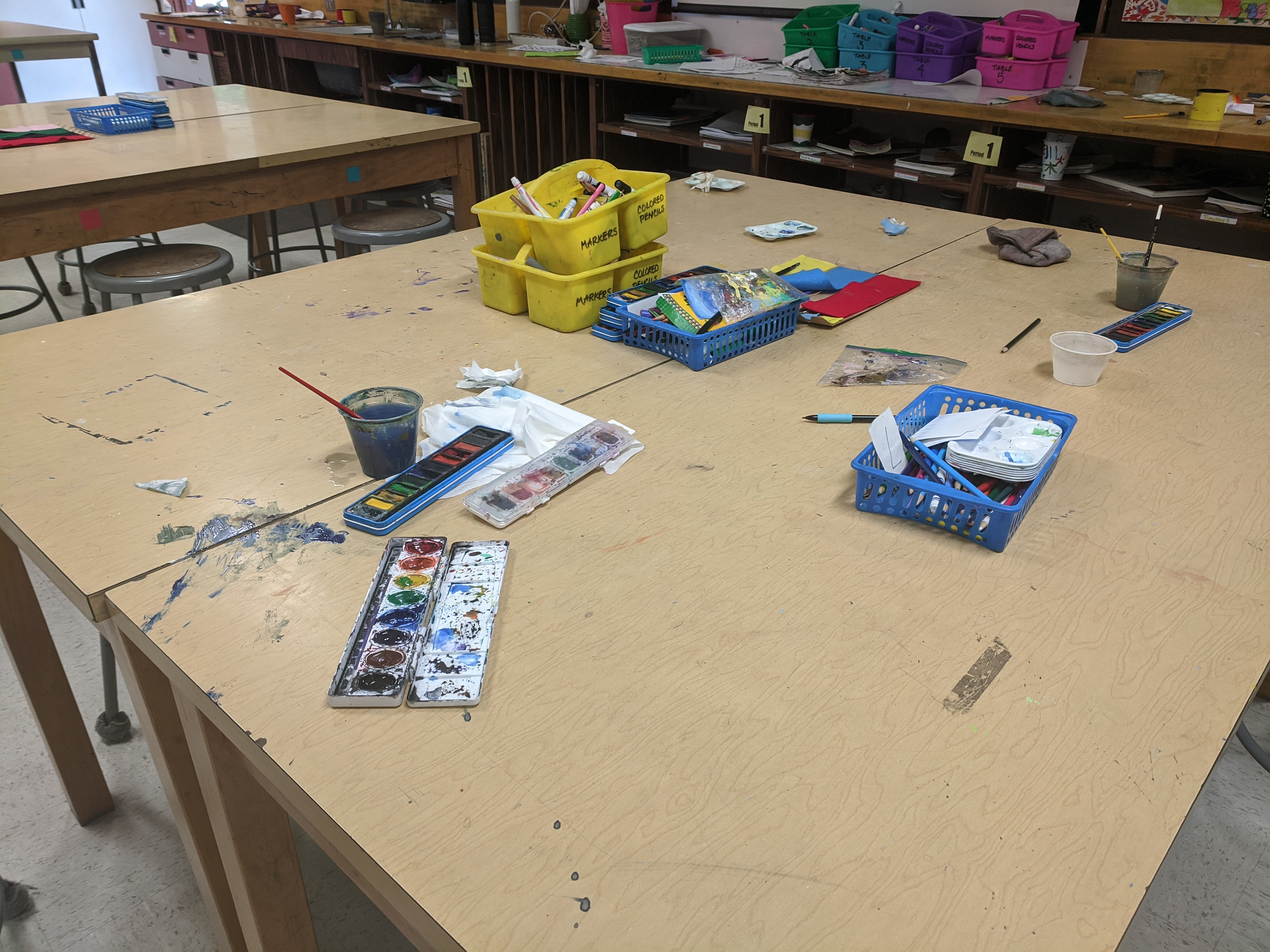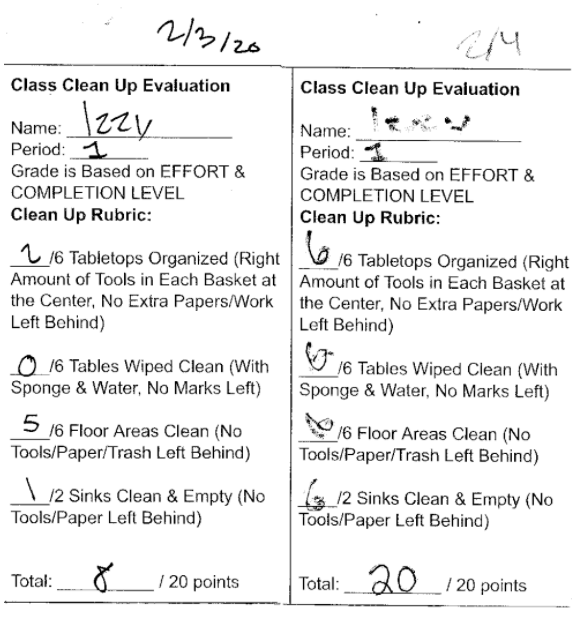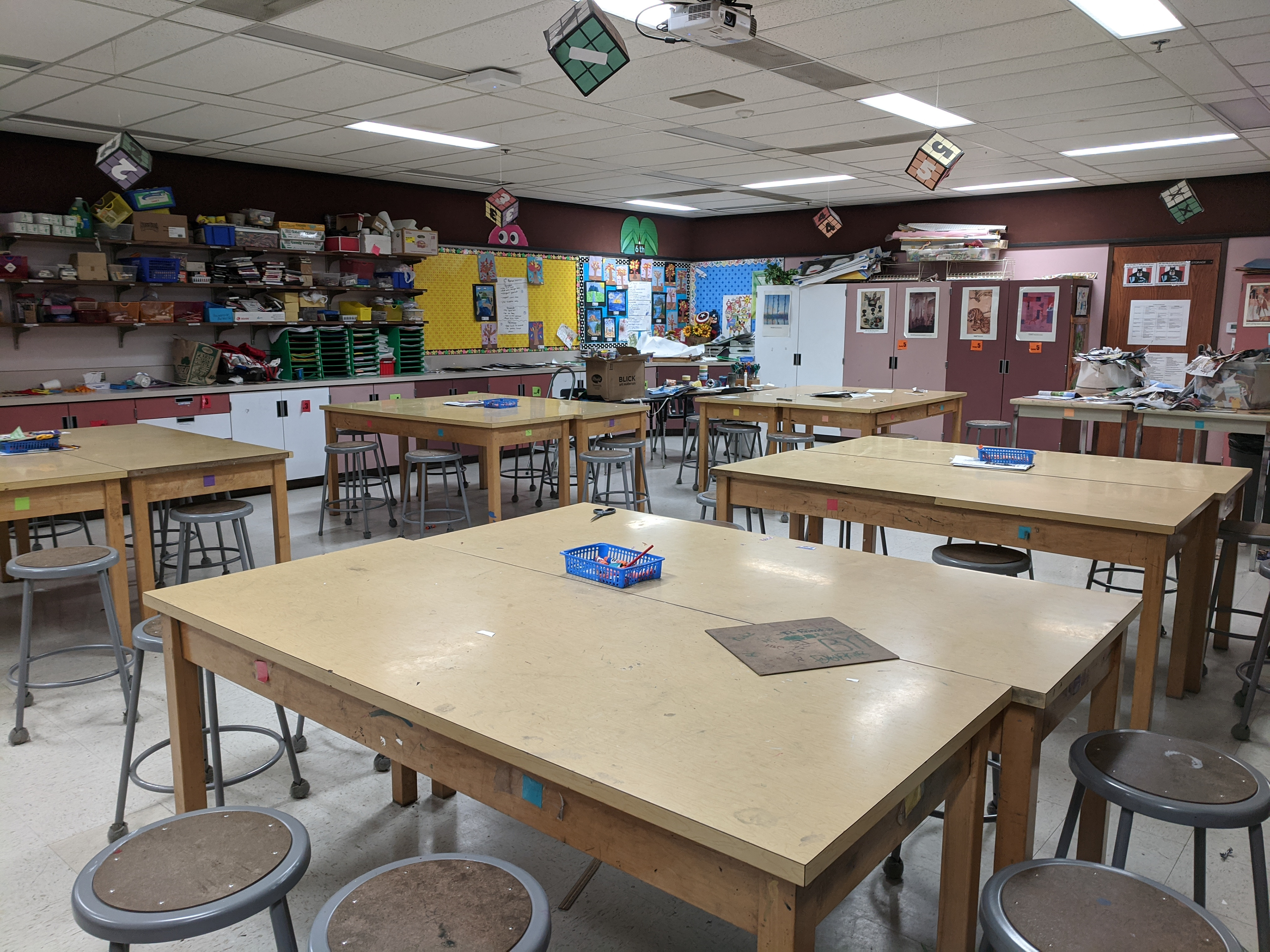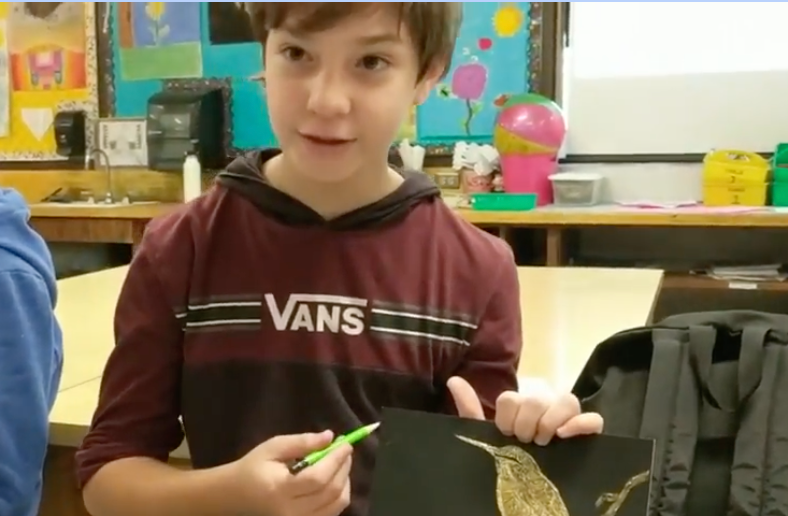Evidence of Learning
Before & After: Implementing Routines for Clean Up & Maintenance of the Studio






When I found myself cleaning up after 6 art classes each day due to my own lack of communication regarding expectations and classroom job assignments, I realized I needed to implement more structure into the learning environment with respect to clean up and maintenance of the shared studio space. For my third Inquiry, I assigned classroom jobs to pairs of students based on their seating arrangement and I implemented a peer-evaluation routine for clean up effort.
At the beginning and end of each workday during Inquiry 3, I incorporated student-assessed data to review and reflect on the class’ clean up efforts. Selected students used a small checklist to assess the maintenance effort in various areas of the room that I had expected to be cleaned and organized daily. I specifically assigned a responsible student from my 1st and 6th period classes to be the "evaluator" for their class’ clean up time. Students evaluated their class at the end of the day and shared their findings the next day to start off each new work period.
The day after each evaluation, the evaluator was to share with their class how well they did the previous day on cleaning each area of the room. The evaluator was also asked to share details about a particular area that could be improved upon for the current day at clean up time. The second day of the checklist, period 1 did a great job cleaning up thoroughly (See "After" photos in the grid above). They did so well that the evaluator instinctively rated them 6 points out of 6 for each area of the checklist, although there were only 2 possible points to be gained for the sink area (we only have 2 sinks in the room).
Hearing their low score on clean up from the previous day, coupled with having enough time structured into the work period to clean up after themselves thoroughly, motivated more students to participate in clean up and correctly perform their classroom jobs. Having been evaluated by a peer who turned their attention to specific focus areas of the room to clean up better the next time was effective in maintaining the physical learning environment.
Since the peer-evaluation process of classroom jobs made a positive impact in the 8th grade class at the beginning of the day, I will continue to use it to start each day off with a nice, clean room for the rest of the classes. This inquiry overall helped me establish and evaluate routines for cleanup in a way that enhances the students’ accountability for maintaining a clean experience of the learning environment.
Evidence of Learning
Kagan Structured Peer-Critique: Rotating Lines Discussion Format


Transcript of Peer Presentation:
K: So this is the bunny I did. You could see the flowers.
C: [crosstalk] That’s a cute bunny, not gonna lie.
K: See, I could kind of try to use stippling in the face. Colored in all the white parts in the ears and then around the eyes and around the nose and then the chin. Got a little bit of the lines for grass. Got like, a small sun in the top. Uhm, and I also did little lines to try to make fur, whole bunch of fur, especially on the nose. Uhm, then some white outlines on the side of the eyes. And that’s pretty much it. And then I also shaded the white part of the body right here.
Mendoza: Kay, good. If you can hear me clap once, if you can hear me clap twice. Now side A, please give your partner some compliment sandwich style of feedback. Kay? Ready, begin.
C: That was probably like the best bunny, you know, like, cool bunny. That like, bunny was like, really cool. And that bunny was amazing. And, yeah.
K: It was an alright bunny it wasn’t the best. It was pretty cool.
C: Yeah, the bunny.
C: Yeah, the bunny.
Mendoza: Could anything be improved?
C: Uhm, nah. It’s a perfect bunny.
C: Uhm, nah. It’s a perfect bunny.
C: Oh, present, yeah, this is my bird. Like, I just did the bird and I drew sun, right. And I drew a twig that he sits on.
K: You could have added a little more background.
C: Yeah, but I like pure black. And, and, that’s all I did. Yeah. The bird.
K: That’s a good looking bird.
C: Good bird.
Mendoza: Please give compliment sandwich feedback style to side A.
K: Uhm, It’s a, it’s a pretty cool- it’s uh actually a really good bird. If you had some background it would have kinda been good. I like how you colored in the twig for whiteness. The bird looks really good. If you would have actually did a little bit more detail on the sun instead of doing lines, and like colored it in a little bit, it would have looked better. But altogether the bird’s pretty tight, I like it.
C: His name is Hogarth. Hogarth the bird.
K: It’s a good bird though, not gonna lie.
C: Okay.
K: I also like how you colored in the bird especially on the beak where the white would be. [crosstalk] But yeah it’s a good bird. I like it.
C: Okay.
K: I also like how you colored in the bird especially on the beak where the white would be. [crosstalk] But yeah it’s a good bird. I like it.
As a prerequisite to this inquiry on effective learning environments, students had been assigned to groups with designated seat color labels at each table. With a designated place to be, it had been easier for me to redirect them when they are off-task and sitting out of order, as well as call on students at random to participate in discussion. Using the seat color system, I had been able to arrange students by behavioral level in a way that structured interactions between diverse peers that would not have otherwise naturally occurred in the classroom. Using the colors as behavioral markers allowed me to translate the seating chart into an organizational tool to manage students with various patterns of behavioral engagement.
The next environmental change needed for this inquiry was the introduction of the Kagan structures for discussions. Students were introduced to 3 types of Kagan structures: Stand Up- Hand Up- Pair Up, Rally Robin, and Rotating Lines. Rotating Lines was a more challenging structure for students to practice as this one required students to take more clear turns with regard to listening and speaking and they had not been used to following such expectations in previously unstructured discussions and presentations. I had felt the need to redirect more conversations in order to ensure students were truly practicing the speaking roles assigned in this format, but with this guidance, student engagement improved.
While Rotating Lines was a particularly challenging structure for the students overall (there was additional resistance to the order because it was very concentrated in the center of the room and it allowed only for slow movement in critique rotation), students got the hang of the structure and were able to use it more effectively for their final critique on their scratch art project as compared to less-structured small group and partner critiques in the past. For instance, Student K exhibited a high level of behavioral engagement during his presentation and critique of his partner’s work, as compared to his engagement with previous critiques. He used discipline specific vocabulary, “stippling,” to describe his scratch technique in a specific area of his artwork, “especially around the nose.” Student K did exhibit low behavioral engagement at other times during the critique days even with the Rotating Lines structure, laughing with friends and making musical “beats” with his pencil, but he demonstrated growth in his own presentation practice and feedback delivery. Student K’s partner, Student C, also demonstrates a level of behavioral engagement with the task that he would not usually present as a student with an IEP for his behavior. The structure of the critique allowed him to grasp when he was to listen and when he was to speak about his own work and he complied well with the roles. These two challenging students have been exhibiting positive behavioral development in art class, which I believe is in part due to their seating and Kagan discussion formats.
The learning environment is becoming stronger through Kagan structures as the interactions between students allow them to help one another engage in the thinking activities, as opposed to when students chose their own critique partners or were limited to discussions at their table- with the same partners for multiple discussion sessions. I will continue implementing Kagan structures in my teaching practice to allow students more opportunities for movement and positive interdependence.
Statement of Candidate Strengths
"I am glad to have the opportunity to offer a positive report in regards to Isabella’s professionalism, reliability, work ethic, and care for students.
I had the opportunity to observe Isabella on several occasions during her assignment. She effectively implemented lessons based on the art standards and incorporated technology, Kagan strategies, note taking, student interaction, and collaboration into her lessons. As a first-year teacher, Isabella was receptive to trying new strategies from trainings, her mentor, and from administration. She understood the components of a good lesson and began all of her lessons with focused essential questions which served to guide her instruction and establish a purpose for learning. She often used rubrics to allow students to critique their artwork and as a means to assess their learning. During her lessons, she checked for understanding and walked around to monitor her students. Isabella continued throughout the year to refine and improve her classroom management and incorporated suggested strategies from administration.
Isabella assisted her students in creating remarkable pieces of artwork for the district Art Festival and attended the weekend event to show support for her students. Isabella was a team player who was willing to complete any task asked of her.
Isabella’s compassion for her students and work ethic will contribute to her success as an art teacher."
- Sandy Rose, Principal, Vineyard Jr. High